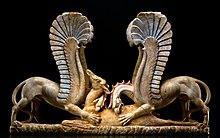Daunias

Daunien (today's Foggia province ) in Apulia , especially the Gargano , was inhabited by the Daunians . These people were of Illyrian descent and related to the Messapians and the Peuketeers . In ancient times the area was called Calabria .
Already in the Paleolithic (1,000,000–35,000 BC) humans left their traces in the entire area of the Gargano . He found an ideal habitat here with a mild climate, drinkable spring water, fertile soils rich in fruit and game and rich fishing grounds along the coast. The main inhabited areas were Vallecoppe , Campi , Costella , Puntalunga , Macchione , Passo dell'Arciprete , Sfinalicchio . The residents worked the flint found throughout the area to make tools for handicrafts, hunting and defense. Not so long ago, a large stone tool making facility was discovered in the Defensola area about 3 km north of Vieste . This is one of the largest flint mines in Europe.
In the Neolithic Age , the fertile plain of this lowland was densely populated by hundreds of villages, all of which were surrounded by a moat. During the Bronze Age , larger, mostly fortified settlements emerged, some of which had a protourban character. In the heavily fortified settlement of Coppa Nevigata , located on a lagoon, tens of thousands of fragments of purple snail shells were found, mainly in layers from the 18th to 13th centuries BC. Discovered that make an early purple production likely. Evidence could also be provided that as early as the 18th century BC Chr. Olive oil was used. For some places contacts with Mycenaean Greece are documented for the Middle Bronze Age, some of which already existed in the 16th century BC. And in the 14./13. Century BC Intensified strongly.
The immigration of population from areas of the eastern Adriatic took place in the 11th / 10th. Century BC A massive layer of destruction in Ascoli Satriano and the abandonment of other settlements during this period could indicate that this was not always peaceful . When in this region one can speak of the culture or a "people" of the Daunians (and further south in Apulia of Puketier , Messapier ), or from the mixing of immigrated "Illyrian" and native Italian elements such a thing emerged, is uncertain due to the few archaeological finds from the beginning of the 1st millennium. The Daunian culture becomes tangible from the 9./8. Century BC BC, mainly through grave finds, until they were in the 4th to 3rd century BC. In the Greco-Roman culture. From the 7th / 6th Century BC The name Daunier or Daunien is documented in ancient written sources. Particularly noteworthy is their distinctive burial culture set in stone with abundant grave goods. Their dead were buried in a lateral position, with their legs drawn up (stool position) facing north-south and facing east.
The Daunians first settled on the coast in simple villages and lived from trade and piracy . They later spread in the hinterland, where they mingled with the indigenous population and founded some Greek-style cities. The first contacts with the Aegean world go back to the Bronze Age and Daunien was called the earth of Diomedes by the Hellenes , as he was the founder of many cities. These cities also had a discreet prestige , they even minted their own coins. Trade contacts with the other side of the Adriatic are documented, with wheat being exported and metal products being obtained. The Daunians were first subjugated by the Samnites and later by the Romans .
Culture and writing
In the Museo Civico in the old town of Vieste are archaeological finds preserved from the pre-Roman period, including fragments of a stele , with a with Messapic incised letters epigraphic inscription as "the most outstanding linguistic referred ancient document Daunia". These and other steles that have been found all over Daunien are valuable sources on the everyday life of the Daunians and provide information about their rites , war or hunting, because there are no figural representations in Daunian art. In Ascoli there is a Daun Archaeological Park and extensive private collections on the subject.
See also
Web links
- Article on Daunien ( Memento of February 27, 2014 in the Internet Archive ) (Italian)
Individual evidence
- ↑ Alberto Cazzella, Claudia Minniti, Maurizio Moscoloni, Giulia Recchia: L'insediamento dell 'età del Bronzo di Coppa Nevigata (Foggia) e la più antica attestazione della produione della porpora in Italia. Preistoria Alpina 40, 2004, pp. 177-182. Online as PDF ; Claudia Minniti: Shells at the Bronze Age settlement of Coppa Nevigata (Apulia, Italy). In: Daniella E. Bar-Yosef Mayer (ed.): Proceedings of the 9th Conference of the International Council of Archeozoology, Durham, August 2002. , Oxbow Books, Oxford 2005, pp. 71-81. online at Academia.edu
- ↑ Alberto Cazzella, Giulia Recchia: The Mycenaeans in the central Mediterranaean. A comparison between the Adriatic and the Tyrrhenian seaways. In: Pasiphae. 3, 2009, p. 27 f. ( online version ), with additional literature.
- ↑ A list and brief descriptions of the most important sites , especially those in which Mycenaean ceramics were discovered, can be found in Marco Bettelli, Italia meridionale e mondo Miceneo. Ricerche su dinamiche di acculturazione e aspetti archeologici, con particolare riferimento ai versanti Adriatico e Ionico della penisola Italiana. Florence 2002, p. 20 (each with further literature).
- ↑ this and the following mostly after archaeological research in Ascoli Satriano on the website of the University of Innsbruck (especially subpage topography and history)
- ↑ A proposed connection between the Danuna Sea people and Daunias or the Daunians (e.g. Luuk de Ligt: An 'Eteocretan' insciption from Praisos and the homeland of the Sea Peoples. TALANTA 50–51, 2008–2009) is not taken into account here . P. 151–172), which has not yet been able to establish itself in research.

